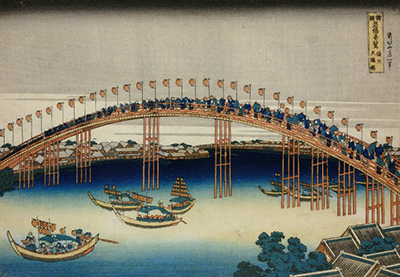Hokusai
Tenma Bridge in Setsu Province by Hokusai
Tenma Bridge in Setsu Province (or “Sesshu tenmabashi” in Hokusai’s native Japanese) is a polychrome woodblock print by Katsushika Hokusai. The work, a woodblock print created using coloured ink, depicts boats sailing down a river underneath the Tenma Bridge. Spectators holding lanterns stand on top of the bridge, watching the boats. The print measures 24.6 cm by 38.1 cm.
These prints appear to have been made between 1831 and 1834. Tenma Bridge in Setsu Province is part of Hokusai’s series, Rare Views of Famous Bridges in All the Provinces. This series includes other works showcasing Japanese bridges of the time period, including Fukui Bridge in Echizen Province and Drum Bridge at the Kameido Tenjin Shrine. Hokusai was likely inspired to create Tenma Bridge in Setsu Province by a previous print made by Utagawa Toyoharu, an earlier ukiyo-e artist who created the Utagawa School of ukiyo-e. Toyoharu’s print also depicted a round, symmetrical bridge during the Tenjin festival’s boat regatta.
Tenma Bridge in Setsu Province is an example of the Nishiki-e woodblock print technique. Usually used within the ukiyo-e style, nishiki-e revolutionized printmaking. The technique involved creating a woodblock for each colour used in a print, which made the process faster and more thorough than it has been in the past when printmakers coloured prints by hand or used one or two ink blocks to add colour to a print. The gradually fading blues of the river at the centre of Tenma Bridge in Setsu Province is a fine example of the nishiki-e technique.
Settsu Province was a historical province in Japan that centred around the city of Osaka. This scene takes place during the Tenjin festival, which was dedicated to the celebration of Tenman Tenjin, the Japanese god of art and learning. The Tenjin festival still takes place today in Osaka, and is said to be one of the world’s best boat festivals. Tenma Bridge in Setsu Province can be found in the Honolulu Museum of Art and New York City’s Metropolitan Museum of Art.
